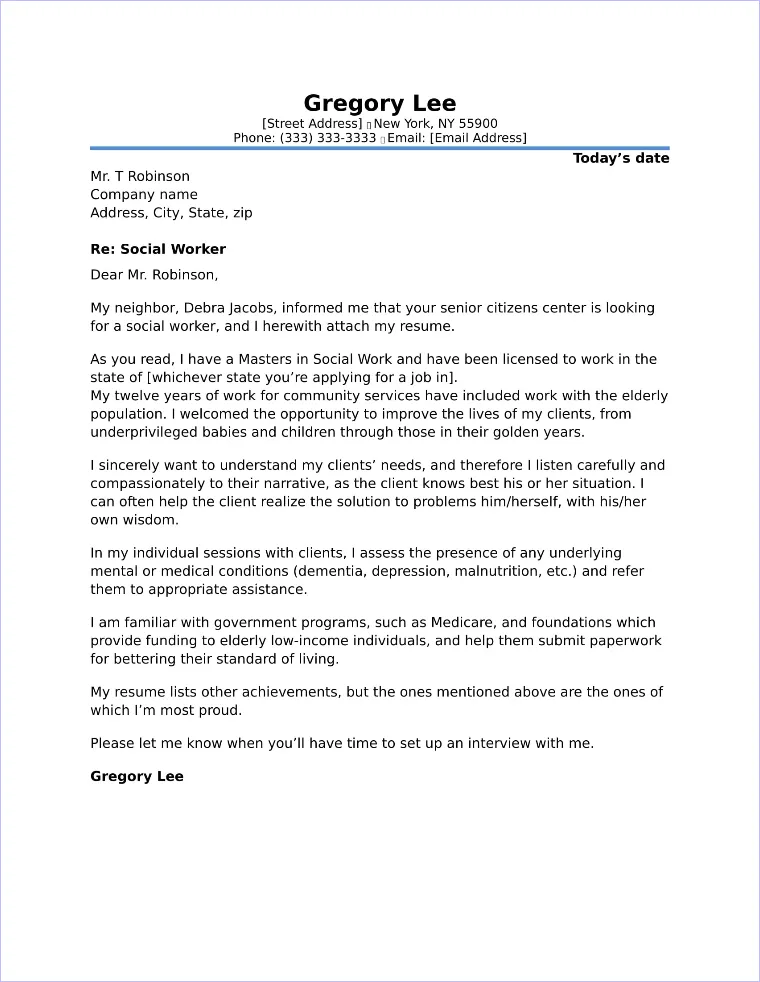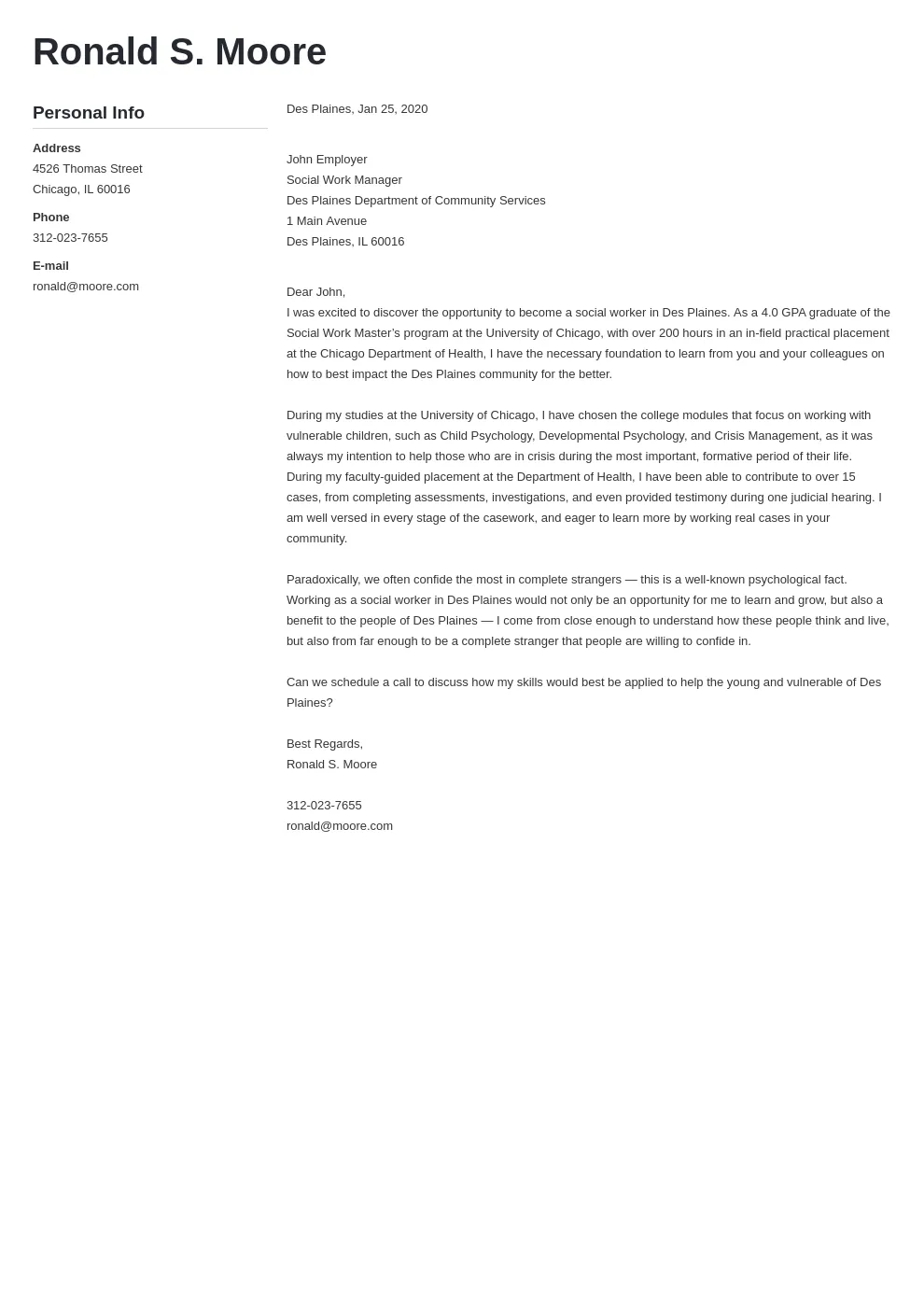What Makes a Social Worker Cover Letter Stand Out
In the competitive field of social work, a well-crafted cover letter is more than just a formality it’s your opportunity to make a strong first impression and showcase your unique qualifications. A compelling cover letter can significantly increase your chances of landing an interview. It allows you to highlight your passion for social work, demonstrate your understanding of the role, and connect your skills and experience directly to the employer’s needs. With numerous candidates vying for the same positions, your cover letter needs to be exceptional to capture the attention of hiring managers. This guide will equip you with the secrets to creating a cover letter that truly shines.
Understanding the Importance of a Strong Cover Letter
A cover letter acts as your personal introduction to the hiring manager. It goes beyond the basic information provided in your resume. A strong cover letter allows you to explain your motivations, share your career goals, and demonstrate your commitment to the social work profession. The cover letter also provides context for your resume, illustrating how your experiences align with the job requirements. It enables you to explain any gaps in your work history or unconventional career choices. By using a cover letter, you can establish your professional writing skills and show your attention to detail, which are crucial qualities in social work. A thoughtful cover letter can separate you from the crowd and highlight your potential to contribute to the organization’s mission.
Addressing the Employer’s Needs

One of the most important steps in creating a winning cover letter is understanding and addressing the specific needs of the employer. Review the job description carefully and identify the key requirements, skills, and qualifications the employer is seeking. Then, in your cover letter, explicitly link your experiences and skills to these needs. Show the hiring manager that you have the qualifications and that you understand the role. Demonstrate how you can contribute to their team. Using keywords from the job description throughout your cover letter can help you get past applicant tracking systems (ATS) and catch the attention of the hiring manager. Personalize your letter by mentioning the organization’s mission or values and explaining how your values align with theirs. Doing so demonstrates that you’ve done your research and are genuinely interested in the opportunity.
Highlighting Your Skills and Experience
Your cover letter is a great opportunity to shine a light on the skills and experience that make you an ideal candidate. However, it’s not enough to list your skills; you must also demonstrate how you’ve applied them in your previous roles. Provide specific examples of your accomplishments and quantify your achievements whenever possible. This allows the hiring manager to see your abilities and the value you can bring to the organization. Instead of stating that you possess strong communication skills, describe an instance where you effectively communicated with a client, resolving a complex issue. Or, if you’re experienced in crisis intervention, share a situation where you successfully managed a critical situation. Be sure to tailor your examples to the requirements of the job description, showcasing the most relevant skills.
Showcasing Relevant Skills and Qualifications
In your cover letter, make sure to highlight skills that are directly related to the job description. Some of the most important skills to include for a social worker are empathy, communication, active listening, problem-solving, crisis management, and cultural sensitivity. Besides these soft skills, consider mentioning any technical skills relevant to the role, such as experience with specific software, case management tools, or knowledge of legal regulations. For each skill you highlight, give examples of how you have used it in previous roles. This can be in the form of a brief story or scenario where you demonstrated the skill, along with the positive results of your actions. By connecting your skills to real-world experiences, you make your qualifications more tangible and memorable to the hiring manager.
Quantifying Your Achievements

Quantifying your achievements in your cover letter is one of the best ways to demonstrate the impact of your work. Quantifiable results provide concrete evidence of your abilities and make your accomplishments more compelling. Whenever possible, use numbers, percentages, or data to show your impact. For example, instead of saying “I improved client outcomes,” state, “I increased client success rates by 15% through implementing a new intervention strategy.” If you’ve been involved in program development, share how many people benefited from the program or how you helped secure funding. Include numbers such as the number of clients you have supported, or the number of training sessions you led. Highlighting specific results helps potential employers better understand your capabilities and the value you can bring to their team.
Tailoring Your Letter to the Specific Job
A generic cover letter is unlikely to impress hiring managers. Instead, customize each cover letter to the specific job you are applying for. This shows that you have taken the time to understand the role and the organization and increases your chances of getting an interview. Research the organization and role before you begin to write. Carefully review the job description and identify the key skills, qualifications, and experience the employer is seeking. Then, align your cover letter content to these requirements. Personalize your letter by mentioning the organization’s mission or values and explaining how your values align with theirs. Make sure your letter reflects your understanding of the job and your enthusiasm for the opportunity. By tailoring your cover letter, you’re demonstrating your interest and attention to detail.
Researching the Organization and Role
Before you begin writing your cover letter, it’s important to thoroughly research the organization and the specific role. Visit the organization’s website to learn about its mission, values, and the services it provides. Look at its social media presence, review any recent news or press releases, and read testimonials from employees or clients. This research helps you understand the organization’s culture and priorities. For the job, carefully analyze the job description and identify the key skills, qualifications, and responsibilities. Consider the setting where the job will take place, for example, a school, hospital, or government agency, and understand any special requirements that are involved. This will give you the context needed to tailor your cover letter and highlight the most relevant experience.
Customizing Your Cover Letter Content

Once you have done your research, use the information to customize your cover letter content. Start by addressing the specific requirements of the job description and highlight your relevant skills and experience. Show the employer that you understand their needs and explain how your qualifications make you a perfect fit. In your cover letter, mention your research to showcase your knowledge of the organization’s mission and values. Explain how your personal values align with theirs and why you are excited about the opportunity. Make sure to use keywords and phrases from the job description throughout your letter, to show that you’ve done your research and are genuinely interested. Tailoring your content demonstrates your interest in the role and increases the chances of getting an interview.
Key Elements of a Compelling Cover Letter
To create a compelling cover letter, you need to include several key elements. A well-structured cover letter will capture the hiring manager’s attention from the beginning. A concise and engaging opening introduces yourself and states the position you’re applying for. The body of your cover letter is where you show your qualifications and demonstrate your suitability for the role. The body should be divided into separate paragraphs, each focusing on a key skill, experience, or accomplishment. Always end the letter with a strong closing statement that reiterates your interest in the role and encourages the hiring manager to contact you. Each of these elements helps the reader see your qualifications and helps you stand out in the field.
The Ideal Structure and Format
A strong cover letter follows a clear and logical structure. Start with a professional header that includes your contact information and the date. Then, address the hiring manager by name if possible. The opening paragraph should introduce yourself and the position you are applying for, along with a brief statement of why you are interested in the role. The body of your cover letter is where you can highlight your relevant experience and skills. Each body paragraph should focus on a particular accomplishment or skill related to the job requirements. The last paragraph summarizes your key qualifications and reiterates your enthusiasm for the position. Ensure the formatting is clean and easy to read, with appropriate spacing and clear fonts. By using a solid structure, your cover letter is easy to follow and understand.
Writing a Powerful Opening and Closing

Your opening paragraph should grab the reader’s attention and give them a reason to continue reading. Make a strong first impression by stating the position you are applying for and a brief summary of your qualifications. You can begin by expressing your excitement about the opportunity. Your closing paragraph should reiterate your interest in the role and include a call to action. Thank the hiring manager for their time and consideration, and state that you look forward to hearing from them soon. Offer to provide any further information or documentation they may need, such as letters of recommendation or references. By using a strong opening and closing, you make a positive impression on the hiring manager.
Avoiding Common Mistakes
When crafting a cover letter, it’s important to avoid common mistakes that can hurt your chances. These mistakes often involve poor grammar, a lack of personalization, and not following the guidelines outlined in the job posting. Proofread your cover letter multiple times before submitting it, and make sure that there are no errors in spelling or grammar. Don’t use generic templates. Customize your cover letter for each specific job application. By avoiding these common mistakes, you can increase the effectiveness of your cover letter and make a strong case for your candidacy.
Grammar, Spelling, and Tone
Proofreading your cover letter is absolutely necessary. Typos, grammatical errors, and a poor tone can significantly hurt your chances of landing an interview. Before submitting your cover letter, proofread it multiple times. Use grammar and spelling checkers to identify any errors. Ensure your language is clear and concise, and that your tone is professional and enthusiastic. Make sure the letter reflects the appropriate level of formality for the organization you are applying to. Request a second opinion from a friend, colleague, or career counselor. A fresh pair of eyes can often spot errors that you may have missed. Ensure your cover letter reflects your professionalism.
Ignoring the Specific Job Requirements

One of the biggest mistakes you can make is ignoring the specific requirements of the job. Failure to tailor your cover letter to the needs of the job will give the hiring manager the impression that you did not take the time to read the job description. To ensure this doesn’t happen, carefully review the job description and identify the key requirements and qualifications the employer is looking for. Then, align your cover letter content to these requirements. Highlight your relevant experience and skills, and quantify your achievements whenever possible. Using keywords and phrases from the job description will show that you understand the role and are a strong candidate. By tailoring your cover letter to the specific job, you increase your chances of getting noticed.
